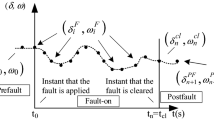Abstract
As an important function of energy management systems, online contingency analysis plays an important role in providing power system security warnings of instability. At present, N-1 contingency analysis still relies on time-consuming numerical integration to assess transient stability. To reduce computational cost, this paper proposes a transient stability analysis method based on homotopy analysis. The proposed method analyzes power system transient stability by computing bifurcation points of nonlinear differential equations. These bifurcation points constitute transient stability region boundaries. The method judges if the post-fault system can survive a disturbance by analyzing whether the initial values following fault clearance locate within the boundaries. The proposed method provides an alternative approach to assessing power system transient stability instead of traditional numerical integration. A simple case is presented to demonstrate application of the proposed method; the analysis results of the proposed method are consistent with the results of numerical integration.





Similar content being viewed by others
Notes
This statement is based on physical analysis of power systems and is verified by a large number of simulation results.
Mathematic software such as Matlab and Mathematic have Bessel function library.
References
Wang, S., Meng, X., Chen, T.: Wide area control of power systems through delayed network. IEEE Trans. Control Syst. Technol. 20(2), 495–503 (2012)
Wang, S., Gao, W., Sakis Meliopoulos A.P.: An alternative method for power system dynamic state estimation based on unscented transform. IEEE Trans. Power Syst. 27(2), 942–950 (2012)
Chen, Y., Huang, Z., Chavarria-miranda, D.: Performance evaluation of counter-based dynamic load balancing schemes for massive contingency analysis with different computing environments. In: Proceedings of the IEEE/PES General Meeting, Minneapolis, 25–29 July. IEEE, Piscataway (2010)
Huang, Z., Chen, Y., Nieplocha, J.: Massive contingency analysis with high performance computing. In: Proceedings of the IEEE/PES General Meeting, Calgary, Canada, 26–30 July. IEEE, Piscataway (2009)
Makarov, Y., Du, P., Kintner-Meyer, M., Jin, C., Illian, H.: Sizing energy storage to accommodate high penetration of variable energy resources. IEEE Trans. Sustain. Energy 3(1), 34–40 (2012)
Makarov, Y., Etingov, P., Samaan, N., Lu, N., Ma, J., Subbarao, K., Du, P., Kannberg, L.: Improving performance of power systems with large-scale variable generation additions. In: Proceedings of the 2012 IEEE/PES General Meeting, San Diego, CA, 22–26 July 2012
Brucoli, M., Roma, A.D., Scala, M.L., Trovato, M.: Parallel-in-time method based on shifted-picard iterations for power system transient stability analysis. Eur. Trans. Electr. Power 4(6), 525–532 (1994)
Aloisio, G., Bochicchio, M.A., La Scala, M., Sbrizzai, R.: A distributed computing approach for real-time transient stability analysis. IEEE Trans. Power Syst. 12(2), 981–987 (1997)
La Scala, M., Sblendorio, G., Bose, A., Wu, J.: Comparison of algorithms for transient stability simulations on sheared and distributed memory multiprocessors. IEEE Trans. Power Syst. 11(4), 2045–2050 (1996)
La Scala, M., Sblendorio, G., Sbrizzai, R.: Parallel-in-time implementation of transient stability simulations on a transputer network. IEEE Trans. Power Syst. 9(2), 1117–1125 (1994)
Liu, C., Thorp, J.: New methods for computing power system dynamic response for real-time transient stability prediction. IEEE Trans. Circuits Syst. 47(3), 324–337 (2000)
Ilic-Spong, M., Crow, M., Pai, M.A.: Transient stability simulation by waveform relaxation methods. IEEE Trans. Power Syst. 2(4), 943–949 (1987)
Ma, F., Vittal, V.: Right-sized power system dynamic equivalents for power system operation. IEEE Trans. Power Syst. 26(4), 1998–2005 (2011)
Wang, S., Lu, S., Lin, G., Zhou, N.: Measurement-based coherency identification and aggregation for power systems. In: Proceedings of the IEEE/PES General Meeting, San Diego, CA, pp. 22–26 (2012)
Chow, J., Accari, P., Price, W.: Inertial and slow coherency aggregation algorithms for power system dynamic model reduction. IEEE Trans. Power Syst. 10(2), 680–685 (1995)
Price, W., Hargrave, A., Hurysz, B., Chow, J., Hirsch, P.: Large-scale system testing of a power system dynamic equivalencing program. IEEE Trans. Power Syst. 13(3), 768–774 (1998)
Huang, Z., Du, P., Kosterev, D., Yang, S.: Generator dynamic model validation and parameter calibration using phasor measurements at the point of connection. IEEE Trans. Power Syst. 28(2), 1939–1949 (2013)
Pai, M.A., Padiyar, K.R., Radhakrishna, C.: Transient stability analysis of multi-machine AC/DC power systems via energy-function method. IEEE Trans. Power Appar. Syst. 12, 5027–5035 (1981)
Pai, M.A., Mohan, M.A., Rao, J.G.: Power system transient stability: regions using Popov’s method. IEEE Trans. Power Appar. Syst. 5, 788–794 (1970)
Sauer, P., Pai, M.A.: Power System Dynamics and Stability. Prentice Hall Inc., Englewood Cliffs (1998)
Liao, S.: Beyond Perturbation: Introduction to the Homotopy Analysis Method. CRC Press, Boca Raton (2003)
Liao, S., Tan, Y.: A general approach to obtain series solutions of nonlinear differential equations. Stud. Appl. Math. 119(4), 297–354 (2007)
Liao, S.: Notes on the homotopy analysis method: some definitions and theorems. Commun. Nonlinear Sci. Numer. Simul. 14(4), 983–997 (2009)
Liao, S.: Series solution of nonlinear eigenvalue problems by means of homotopy analysis method. Nonlinear Anal. Real World Appl. 10(4), 2455–2470 (2009)
Acknowledgments
The authors are grateful to the support from the Future Power Grid Initiative to this work through Laboratory Directed Research and Development Project “A multi-layer data-driven reasoning tool for smart grid integrated information systems.” The Pacific Northwest National Laboratory is operated for the U.S. Department of Energy by Battelle under Contract DE-AC05-76RL01830. Also, the authors gratefully acknowledge the contribution of Dr. Yinlong Zhao and Dr. Wenrui Hao for their help in Homotopy Analysis.
Author information
Authors and Affiliations
Corresponding author
Rights and permissions
About this article
Cite this article
Wang, S., Du, P. & Zhou, N. Power system transient stability analysis through a homotopy analysis method. Nonlinear Dyn 76, 1079–1086 (2014). https://doi.org/10.1007/s11071-013-1191-2
Received:
Accepted:
Published:
Issue Date:
DOI: https://doi.org/10.1007/s11071-013-1191-2




